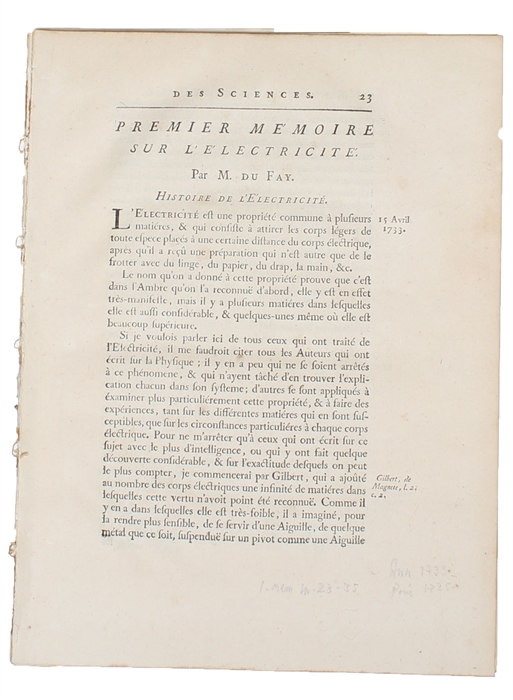THE DISCOVERY OF POSITIVE AND NEGATIVE CHARGE OF ELECTRICITY
DU FAY, CHARLES FRANCOIS de CISTERNAY.
Premier- (Quatrième) Mémoire sur L'Électricitè. (1. Histoire de L'Électricité. 2. Quels sont les Corps qui sont susceptibles d'Électricité. 3. Des Corps qui sont le plus vivement attirés par les matiéres électriques, & de ceux qui sont les plus propres à transmettre l'Électricité. 4. De l'Attraction & Répulsion des Corps Électriques.). 4 Memoirs.
(Paris, L'Imprimerie Royale, 1735). 4to. Without wrappers. Extracted from "Mémoires de l'Academie des Sciences. Année 1733". Pp. 23-39, pp. 73-84, pp. 233-254 a. 1 engraved plate, pp. 457-476. With titlepage to the volume (1733/1735).
First appearance of these milestone papers in the histroy of electricity in which Dufay explains his discovery of two kinds of electricity and the relation between them, attraction and repulsion, shocks and sparking, and the full recognition of electrostatic repulsion. He formulates the two-fluid theory of electricity. He further showed that "not all bodies can become electrified themselves" (by friction) and went on to show, "that they can all acquire a considerable (electrical) virtue when the tube (of rubbed) glass), wood, metals or liquids are brought near them,", provided only that they are insulated by beiing stood on "a support of glass or of sealing-wax".
Dufay "TRANSFORMED A COLLECTION OF MISCELLANEOUS WEEDS INTO THE FIRST GARDEN OF EUROPE" (Heilbron)
"Dufay's substantive discoveries - ACR, the two electricities, shocks and sparking - are but one aspect, and perhaps not the most significant, of his achievement. His insistence on the impiortence of the subject, on the universal character of electricity, on the necessity of organizing, digesting and regulariizing known facts before grasping new ones, all helped to introduce order and professionel standards into the study of electricity at precisely the moment when the accumulation of data began to require them. He foundthe subject a record of often capricious, disconnected phenomena, the domain of the polymaths, textbook writers, and prfesional lecturers, and left a body of knowledge that invited and rewarded prolonged scrutinity from serious physicists." (Heilbron "Electricity in the 17 & 18 Centuries", p. 260).
Parkinson "Breakthroughs", 1734 P - Ronalds Library, p. 145. - Not in Wheeler Gift Cat.
Order-nr.: 51268

